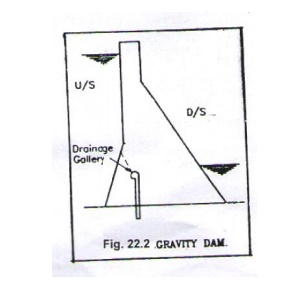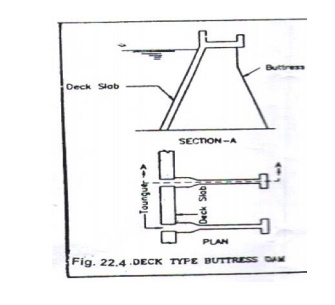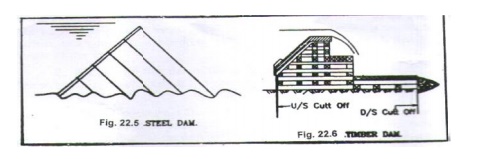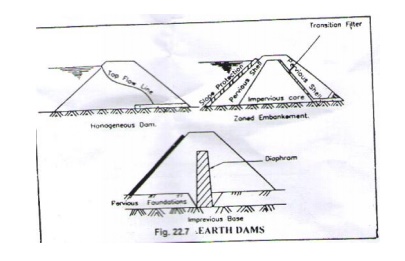Chapter: Civil Engineering : Building Components and Structures
Dams
DAMS
1 Introduction
2 Purpose of a dam
3 Factors governing selection of site for dam
4 Classification of dams
INTRODUCTION
A dam is an impervious barrier
construction across a river to store water. The side on which water gets
collected is called the upstream side, and the other side of the barrier is
called the downstream side. The lake of water which is collected in the
upstream side is called as reservoir. This water is then utilized as and when
it is needed.
PURPOSE OF A DAM
1. To store
and control the water for irrigation
2. To store
and divert the water for domestic uses
3. To supply
water for Industrial uses
4. To
develop hydroelectric power plant to produce electricity
5. To
increase water depths for navigation
6. To create
storage space for flood control
7. To
preserve and cultivate the useful aquatic life
8. For recreational
purposes.
Multipurpose Reservoirs
A reservoir planned and
constructed to serve not only one purpose but various purposes together is
called a multipurpose reservoir.
Reservoir, designed for one purpose, incidentally serving
other purposes, shall not be called a multipurpose reservoir.
Hence a reservoir designed to protect the down
stream areas from floods and also to conserve water for water supply,
irrigation, industrial needs, hydroelectric purposes etc. shall be called as
MULTIPURPOSE RESERVOIR.
FACTORS GOVERNING
SELECTION OF SITE FOR DAM
1. Suitable
foundations should be available at the site selected for a particular type a
dam. For gravity dams, sound rock is essential. For earth dams, any type of
foundations is suitable with proper treatment.
2. The river
cross-section at the dam site should preferably have a narrow gorge to reduce
the length of the dam. However, the gorge should open out u/s to provide large
basin for a reservoir.
3. The
general bed level at dam site should preferably be higher than that of the
river basin. This will reduce the height of the dam and will facilitate the
drainage.
4. A
suitable site for the spillway should be available in the near vicinity. If the
spillway is to be combined with the dam, the width of the George should be such
as to accommodate both.
5. Materials
required for the construction should be easily available, either locally or in
the near vicinity, so that the cost of transporting them is as low as possible.
6. The
reservoir basin should be reasonably water tight. The stored water should not
escape out through its side walls and bed.
7. The value
of land and property submerged by the proposed site should be as low as
possible.
8. The dam
site should be easily accessible so that it can be economically connected to
important towns and cities by rails, roads, etc.
9. To
establish site for labour colonies, a healthy environment should be available
in the near vicinity.
CLASSIFICATION OF DAMS
Dams may be classified into
different categories, depending upon the basis of the classification.
(a) Classification according to use : Based on use, dams are classified
as follows
:
i.
Storage dam ii. Diversion dam iii.
Detention dam
i. Storage
Dam : Storage dam is constructed to store water to its upstream side
during the periods of excess supply in the river (i.e. during rainy season) and
is used in periods of deficient supply.
ii. Diversion
Dam : Diversion dam supply raises the water level slightly in the
river and thus provides head for carrying or diverting water into ditches,
canals or other conveyance systems to the place of use.
iii. Detension
Dam : A detention dam is constructed to store water during floods
and release it gradually at a safe rate when the flood reduces.
(a)
Classification
According to Hydraulic Design : According to hydraulic
design, dams may be classified81 as follows :
i.
Non – Overflow
dam ii. Overflow dam
i. Non-Overflow Dam :
A
non-overflow dam is the one in which the top of the dam is ke pt at a higher
elevation than the maximum expected high flood level.

ii. Over Flow Dam :
An overflow dam is the one which
is designed to carry surplus discharge (including floods) over its cr est.
Usually, in a river valley
project, the two types of dams are combined. The main dam is kept as a non – over
flow dam and some portion of dam is kipt as o verflow dam (spill way)at some
suitable lo cation along the main dam.
c) Classification according to
material : According to this classification, dam may be classification,
dam may be classified as follows : i. Rigid dam ii. Non-rigid d am
i. Rigid Dams : Rigid
dams are those which are constructed of rigid m aterials such as
masonry, concrete, steel o r timber. Rigid dams may be further classified as
follows:
1. Solid
Masonry gravity damm
2. Solid
concrete gravity dam
3. Arched
masonry dam
4. Arched
concrete dam
5. Concrete
buttress dam
6. Steel dam
7. Timber dam
ii. Non-Rigid Dams : Non
-rigid dams are those which are constructed of non-rigid materials such
as earth and or rockfill. The most common types of non-rigid dams are :
1. Earth dam 2. Rockfill dam
Gravity dams : A gravity dam is the one
in which the external forces (s uch as water pressure, wave pressure,
silt pressure, uplift pressure etc.) are resisted by the weight of the dam
itself. A gravity dam may be constructed either of masonry or of concrete.
Masonry gravity dams are now-a-days constructed of only small heights. A ll
major and important gravity dams are now constructed of concrete only. A
gravity dam may be either straight or curved in plan.

Arch dams : An arch dam is a dam
curved in plan and carries a maj or part of its waterload horizontally
to the abutments by arch action. The thrust developed by the water load carried
by arch action e ssentially require strong side walls of the canyon to resist
the arch forces. The weight of arch dams is not counted on to assist mat
erially in the resistance of external loads.

Butter Dams :
A buttress dam consists of a
number of buttresses of piers. These pi ers divide the space (i.e. the space to
be d ammed) into number of spans. Between these piers, panels are constructed
of horizontal arches or flat slabs. When the panels consist o r arches, it is
known as Multiple arches type buttress dam. If the panels consist of
flat slab, it is known as Deck type buttress dam.
Steel Dams : Steel
dams are constructed with a frame work of steel with a thin skin plate as
deck slab, on the upstream side. Steel dams are generally of two types.
i.
Direct Strutted ty pe
ii.
Cantilever type

In the direct strutted type, the
load on the deck plate is carried directly to the foundation through inclined
struts. In the cantilever type, the deck is formed by a cantilever truss i.e.
the deck i s anchored to the foundation at the u/s toe.
Timber Dams : A timber
dam is constructed of framework of timb er struts and beams, with timber
plan faci ng to resist water pressure. They are suitable in places where timber
can be available in plenty.

Earth Dams : Earth
dams are made of locally available soils and gravel s. Therefore, these
type of dams are used upto moderate heights only. Their construction involves
utilization of materials in the natural state requiring a minimum of processin
g.
Following are the three types of earth dams
i.
Homogeneous em bankment type
ii.
Zoned embankme nt type
iii.
Diaphragm emba nkment type
i. Homogeneous
embankm ent type : In this type, dam is composed of a s ingle kind of
material. But this dam is structurally weak. To check the seepage throug h
the dam a horizontal filter drain or rock toe is provided.
ii. Zoned
embankment type : In this type, the dam is made up of more thn one
material. Usually this dam consists of central impervious core and outer
previous shell as shown in figure. A suitable drainage s ystem, in the form of
horizontal drain or a ro ck toe is also provided.
iii. Diaphragam type emba nkment : In this
type, a thin diaphragam of impermeable materials is pro vided at the
centre of the section to check the seepage. The diaphgram may be made of cement
masonry, cement concrete or impervious soils.

Rock fill dams : In this
type, variable sizes of rocks are used to form the embankment. The rock
fill d am usually consists of the following four parts.
i.
Main rock fill at the down – stream
side
ii.
Up - stream
rock – cushion
of laid – up
stone.
iii.
Up – stream
impervious membrane resting on the upstream rock cushion.
iv.
Up stream cut-off
to check the sub soil seepage

Basics of Interior Design annd Landscaping
Interior design means suc cessful
renovation to make cosmetic impro vements, not structural improvements, to h
ouse
An interior designer is a person
who is considered a professional in the fie ld of interior design or one who
designs interiors as part of their job.
Interior designing is a pract ice
concerned with anything that is found in side a space-walls, windows, door,
finish es, and textures. Light etc. All of these elements are used by
interior designers to develo p a
functional, safe, and aesthetically pleasing space for a building’s
user.
They plan the spaces of alm ost
every type of building including hotels, corp orate spaces, schools, hospitals,
private residence, shopping malls etc. Today, interior d esigners must be attuned
to architectural detailing including: floor plans, home reno vations, and
construction codes.
Related Topics